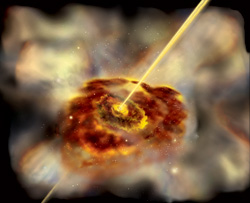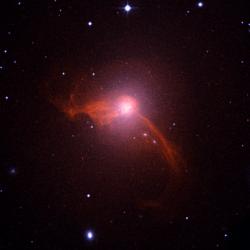Active Galaxies

Artist's concept of an active galaxy.
ENLARGE Image
Credit: Aurore Simonnet
NASA E/PO,
Sonoma State University
Nearly every massive galaxy seems to have a supermassive black hole, but only a few percent appear to be active. Our galaxy's central black hole is dormant, and this and similar black holes are not included in the Swift satellite census. All black holes were likely once active, and why some remain active and others are dormant in the modern, local universe is a mystery.
The all-sky survey contains more than 200 supermassive black holes called Active Galactic Nuclei, or AGN, and provides a definitive census of black hole activity in the local universe. The team uncovered many new black holes that were previously missed, even in well-studied galaxies, and other surprises as well.
AGN have a mass of millions to billions of suns, which are confined within a region about the size of our solar system. The term "active" refers to the process of actively pulling in gas and whole stars and generating copious amounts of energy from a tiny galactic core in the process. Examples include quasars and Seyfert galaxies.
The Swift satellite was built primarily to study gamma-ray bursts. During waiting times between bursts, Swift's Burst Alert Telescope, which is sensitive to the highest-energy X-rays, scans the sky. AGN generate X-rays as well as many other forms of light. Many AGN, however, are hidden behind dust and gas, which block lower-energy light, such as visible light. Because higher-energy X-rays are so penetrating, Swift can detect AGN missed by other surveys, allowing for an unbiased count.
For more visit: NASA Performs Headcount of Local Black Holes
_______________________________________________________
Chandra Reviews Black hole Musical
_______________________________________________________

A gigantic sonic boom generated by a supermassive black hole has been found with NASA's Chandra X-ray Observatory, along with evidence for a cacophony of deep sound.
ENLARGE Image
This discovery was made by using data from the longest X-ray observation ever of M87, a nearby giant elliptical galaxy. M87 is centrally located in the Virgo cluster of galaxies and is known to harbor one of the Universe's most massive black holes.
Scientists detected loops and rings in the hot, X-ray emitting gas that permeates the cluster and surrounds the galaxy. These loops provide evidence for periodic eruptions that occurred near the supermassive black hole, and that generate changes in pressure, or pressure waves, in the cluster gas that manifested themselves as sound.
"We can tell that many deep and different sounds have been rumbling through this cluster for most of the lifetime of the Universe," said William Forman of the Harvard-Smithsonian Center for Astrophysics (CfA).
The outbursts in M87, which happen every few million years, prevent the huge reservoir of gas in the cluster from cooling and forming many new stars. Without these outbursts and resultant heating, M87 would not be the elliptical galaxy it is today
"If this black hole wasn't making all of this noise, M87 could have been a completely different type of galaxy," said team member Paul Nulsen, also of the CfA, "possibly a huge spiral galaxy about 30 times brighter than the Milky Way."
The outbursts result when material falls toward the black hole. While most of the matter is swallowed, some of it was violently ejected in jets. These jets are launched from regions close to the black hole (neither light nor sound can escape from the black hole itself) and push into the cluster's gas, generating cavities and sound which then propagate outwards.
Chandra's M87 observations also give the strongest evidence to date of a shock wave produced by the supermassive black hole, a clear sign of a powerful explosion. This shock wave appears as a nearly circular ring of high-energy X-rays that is 85,000 light years in diameter and centered on the black hole.
For more & animations visit Chandra Reviews Black Hole Musical
more links to NOVA origins by Lubos Motl
_______________________________________________________
_______________________________________________________


<< Home